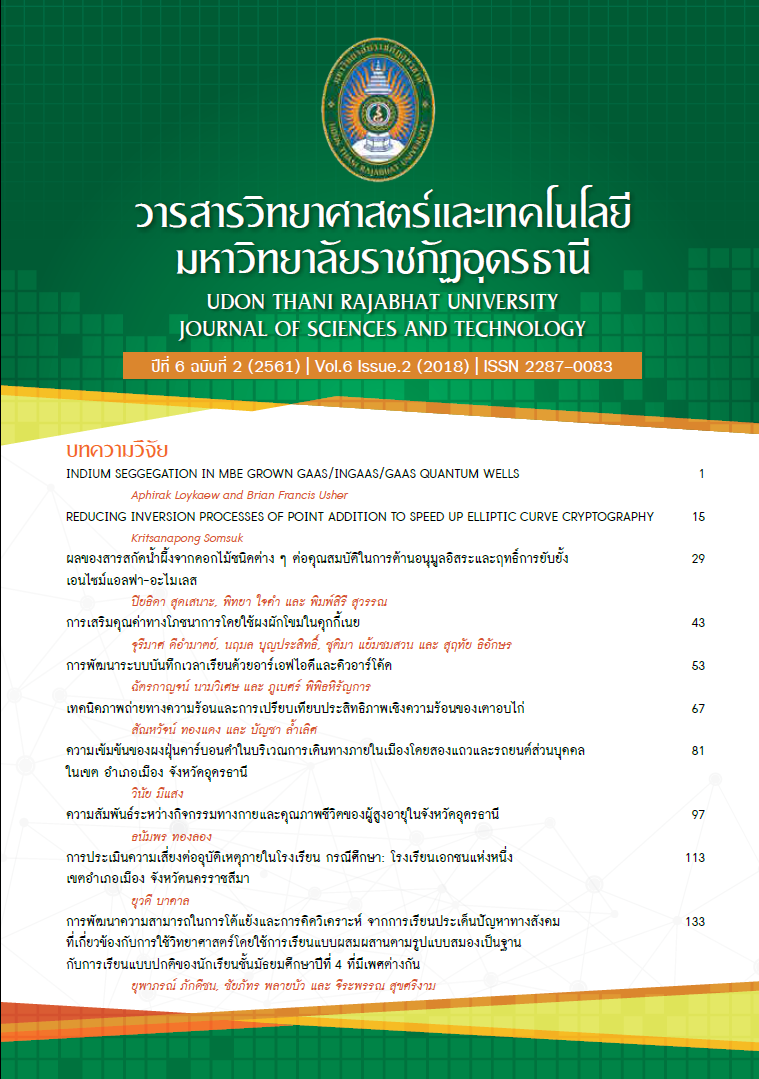THE CONCENTRATION OF BLACK CARBON AEROSOLS IN THE URBAN TRAVEL AREA USED BY MINIBUSES AND PRIVATE CARS IN THE MUANG DISTRICT OF UDON THANI
Main Article Content
Abstract
The research aimed to (1) study the concentration of black carbon in Urban travel areas used by of minibuses and private cars in the at Muang District, of Udonthani and (2).develop a database of air quality management planning for Udon thani. The area for data collection started from the traffic light at the Baan Chan Intersection and continued to Udon Thani Bus Terminal 1 (Udondutsadi Road) The research focused mainly on determining the concentration of black carbon, temperature, relative humidity at specific times. Measurement were made during the rush hours of 06.0-09.00 in the morning and 15.00-18.00 in the afternoon. An Independent-sample t-test was used to statistically analyze the data. The results found that the concentration of black carbon produced by minibuses on the weekends during 08.06-08.10 was the highest 5,881 µg/m3 .At this time the temperature and relative humidity were 30.05 °C, 81.47% respectively. Whereas private cars produced the highest concentration of black carbon, 27,277 µg/m3 from 08.14-08-20 when temperature and relative humidity were 39.60 °C and 72.17% respectively .On weekend (afternoons) from 16.06-16.10 minibuses emissions were the highest 5,681.67 µg/m3 when the temperature and relative humidity 33.50 °C and, 65.87% respectively. The Private cars produced the highest emission of black carbon from 16.12-16.15 32,737 µg/m3 when the temperature and relative humidity of 34.62 °C 56.23% respectively. The highest minibus emission on weekday (mornings) 8,834 µg/m3 was from 08.17-08.20 when the temperature and relative humidity were 30 °C and 83.60% respectively. The Private car emission were the highest 38,617.33 µg/m3 16.12-16.15 the temperature and relative humidity were 33.90 °C were 78.16% respectively. The Weekday (afternoon) minibus emission were the highest 34,985 µg/m3 from 16.15-16.15 the temperature and relative humidity 31.67 °C, 83.63% respectively. The Private cars produced the highest black carbon emissions from 16.15-16.20 when the temperature and relative humidity were 40.60 °C and 71.21% respectively. t-test results showed that, there were no significant difference in carbon emissions during rush hours on the weekdays and the weekend, (P>0.05).
Article Details
References
กรมควบคุมมลพิษ. (2553). ผงฝุ่นคาร์บอนดำในบรรยากาศและภาวะโลกร้อน. สืบค้นเมื่อวันที่ 20 มีนาคม 2560. จาก http://infofile.pcd.go.th/air/AirNoise53_3.pdf
กรมควบคุมมลพิษ. (2557). ผลกระทบของผงฝุ่นคาร์บอนดำ. สืบค้นเมื่อวันที่ 1 ธันวาคม 2560 จาก https://www.facebook.com/PCD.go.th/posts/678501368899920.
นพภาพร พานิช. (2550). ตำราระบบบำบัดมลพิษอากาศ. พิมพ์ครั้งที่ 2 (ฉบับปรับปรุง) ศูนย์บริการวิชาการแห่งจุฬาลงกรณ์มหาวิทยาลัย, กรุงเทพฯ.
World Health Organization [WHO]. (2012). Diesel Engine Exhaust Carcinogenic. International Agency for Research on Cancer. Pages 2-4 .
Xu, J., Jin, T., Miao, Y., Han, B., Gao, J., Bai, Z. and Xu, X. (2015). Individual and population intake factions of diesel particulate matter (DPM) in bus stop microenvironment. Environmental DOI: 10.1016/j.envpol.2015.09.005


